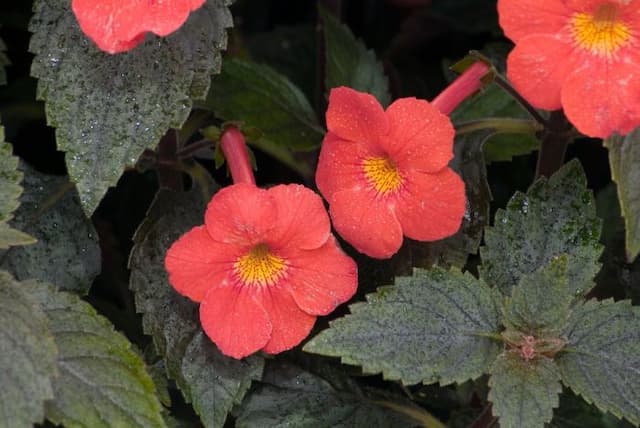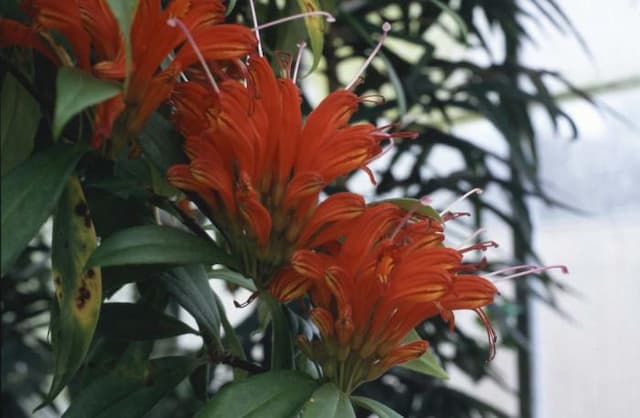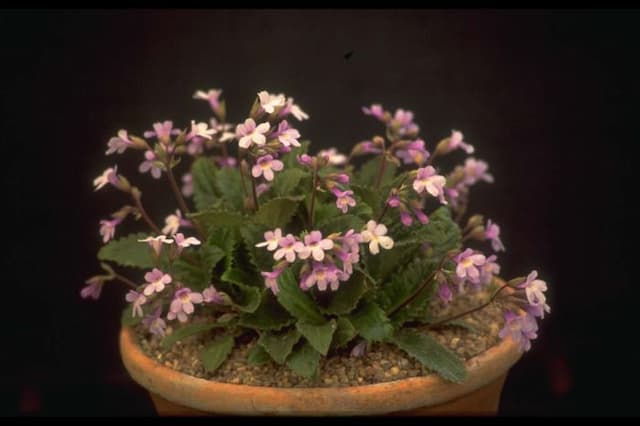Hot Water Plant Achimenes 'Hilda Michelssen'

ABOUT
Achimenes 'Hilda Michelssen', commonly referred to as Magic Flower or Hot Water Plant, is a perennial plant prized for its ornamental appeal. This plant produces lush green foliage that forms a dense and bushy habit, creating a vibrant backdrop for its flowers. The leaves are elongated with a soft texture, and they often display a slight ripple along their edges, adding to the plant’s lush appearance. The standout feature of Achimenes 'Hilda Michelssen' is its striking flowers. These blooms exhibit an array of bright and rich colors, often a mix of pinks, purples, reds, or lavenders, and they are known for having a velvety sheen that catches the light. The flowers are tubular with flared petal margins, looking like little trumpets or stars, which makes them particularly attractive to both humans and pollinators. They grow in clusters, adding a prolific splash of color which contrasts beautifully against the green foliage. Overall, the plant gives a tropical impression and is often grown in hanging baskets or containers where its trailing habit and bountiful blooms can be displayed to full effect. It is a favorite among gardeners who wish to add a long-lasting and vivid pop of color to their indoor or shaded garden spaces.
About this plant
 Names
NamesFamily
Gesneriaceae.
Synonyms
Magic Flower, Nut Orchid, Cupid's Bower, Hot Water Plant.
Common names
Achimenes 'Hilda Michelssen'.
 Toxicity
ToxicityTo humans
Hot Water Plant is generally considered non-toxic to humans. Consequently, ingestion of parts of this plant is not expected to result in poisoning or severe adverse effects.
To pets
Hot Water Plant is also generally regarded as non-toxic to pets. Therefore, if pets consume parts of this plant, they are unlikely to experience significant toxicity or poisoning symptoms. However, it is always prudent to monitor your pets and prevent them from eating plants, as individual reactions can vary.
 Characteristics
CharacteristicsLife cycle
Perennials
Foliage type
Deciduous
Color of leaves
Green
Flower color
Varies
Height
1 feet 8 inches (50 cm)
Spread
1 feet (30 cm)
Plant type
Herb
Hardiness zones
10
Native area
Central America
Benefits
 General Benefits
General Benefits- Easy to grow - Achimenes, commonly known as Magic Flowers, are relatively simple to cultivate and maintain, making them suitable for beginner gardeners.
- Ornamental appeal - With its beautiful and vibrant flowers, this plant adds aesthetic value to gardens and indoor spaces.
- Attracts pollinators - The bright blooms of Achimenes 'Hilda Michelssen' attract beneficial insects such as bees and butterflies, which are essential for the ecosystem.
- Compact size - The plant's compact size makes it ideal for container gardening or small spaces.
- Long blooming period - It has a long flowering season, providing color and interest for a substantial part of the year.
- Variety of colors - Available in a range of hues, the flowers can complement many garden designs or indoor décor themes.
- Shade tolerance - Achimenes 'Hilda Michelssen' can thrive in shaded areas where many other blooming plants might struggle.
 Medical Properties
Medical PropertiesThis plant is not used for medical purposes.
 Air-purifying Qualities
Air-purifying QualitiesThis plant is not specifically known for air purifying qualities.
 Other Uses
Other Uses- Achimenes 'Hilda Michelssen', commonly known as Magic Flower, can be used in terrariums due to their compact growth habit and attractive flowers, adding a vibrant touch to miniature indoor ecosystems.
- The plant can be utilized in educational settings such as schools for plant propagation and biology lessons, demonstrating to students the principles of vegetative reproduction with its easily detachable rhizomes.
- Magic Flower can serve as a living mulch in garden beds, with its dense foliage helping to retain soil moisture and suppress weeds when planted en masse.
- It can be used in hanging baskets for outdoor summer events, such as weddings or garden parties, to create a cascading floral display with its trailing growth habit.
- The colorful blooms of Magic Flower could be used in art projects like pressing flowers, preserving their shape and color for crafts or decoration.
- The plant can be cultivated as part of a butterfly or hummingbird garden, as its flowers are known to attract these pollinators, providing both aesthetic and ecological benefits.
- Due to its aesthetically pleasing appearance, Achimenes 'Hilda Michelssen' can be used in photography props and staging for botanical photography and illustration.
- When grown in clusters, Magic Flower can create a stunning living table centerpiece for restaurants or cafes, bringing a fresh and natural element to the dining experience.
- The colorful blossoms can be floated in decorative water bowls to create temporary water features for spa or wellness center ambiance.
- Holiday-themed planters can incorporate Magic Flower for seasonal displays, using its vibrant blooms to complement festive decor for occasions like Easter or Mother's Day.
Interesting Facts
 Feng Shui
Feng ShuiThe plant_name is not used in Feng Shui practice.
 Zodiac Sign Compitability
Zodiac Sign CompitabilityThe plant_name is not used in astrology practice.
 Plant Symbolism
Plant Symbolism- Beauty: Achimenes, commonly known as "Hot Water Plant" or "Cupid's Bower," often symbolizes beauty due to its attractive and vibrant flowers.
- Charm: The delicate and ornate appearance of its blossoms can represent charm and a pleasing demeanor.
- Coziness: As a plant that thrives in warm environments, it might be seen as emblematic of a cozy and comfortable home or situation.
- Passion: The rich colors of the Hot Water Plant can denote deep emotion or passion, reflecting the intensity of its hues.
- Resilience: Achimenes can symbolize resilience, as it can survive periods of dormancy and return to bloom with vibrancy.
 Water
WaterHot water plants, including the Achimenes 'Hilda Michelssen', should be watered regularly to maintain moist potting mix, without letting the soil become waterlogged. Depending on temperature and humidity, this typically means watering every few days, but allow the top inch of soil to dry out slightly between waterings. In general, provide about 8-16 ounces of water for a standard 6-inch container each time you water, adjusting as necessary for the size of your pot and the environmental conditions. Avoid letting the plant sit in standing water as this can lead to root rot.
 Light
LightHot water plants prefer bright, indirect light, so a spot near a window that receives filtered sunlight would be ideal for Achimenes 'Hilda Michelssen'. Direct sunlight can scorch the leaves, while too little light can lead to weak, leggy growth. East- or west-facing windows typically provide the ideal light conditions for this plant.
 Temperature
TemperatureHot water plants thrive in temperatures between 60 and 75 degrees Fahrenheit; though Achimenes 'Hilda Michelssen' can handle a range from 50 to 80 degrees Fahrenheit. They should not be exposed to temperatures below 50 degrees Fahrenheit as they are not frost-tolerant. The ideal temperature for this plant would be within the typical indoor temperature range, making it a good houseplant.
 Pruning
PruningPrune Hot water plants by removing spent flowers and yellowing leaves to encourage new growth and a more compact bushy form. The best time to prune Achimenes 'Hilda Michelssen' is after flowering or in early spring before new growth begins. They generally don't require extensive pruning, but trimming can help maintain an attractive shape; prune lightly as needed.
 Cleaning
CleaningAs needed
 Soil
SoilThe best soil mix for Hot Water Plant is light, well-draining, and rich in organic matter with a slightly acidic to neutral pH of 6.0-7.0. A mix containing peat moss, perlite, and compost is ideal to ensure adequate drainage and fertility.
 Repotting
RepottingHot Water Plants should be repotted every couple of years or when they outgrow their current pot. It's best to repot them in the spring before they start their active growth period.
 Humidity & Misting
Humidity & MistingThe Hot Water Plant thrives in high humidity conditions, ideally between 60-80%. Maintaining this level of humidity will help replicate its natural tropical habitat.
 Suitable locations
Suitable locationsIndoor
Place Hot Water Plant in bright, indirect light and maintain high humidity.
Outdoor
Grow Hot Water Plant in shade; protect from strong sun and heavy rain.
Hardiness zone
10-11 USDA
 Life cycle
Life cycleThe life cycle of the Achimenes 'Hilda Michelssen', commonly known as Cupid's Bower, begins with dormancy, where the rhizomes or tuberous roots rest typically during the colder months. As temperatures rise and light increases in spring, the rhizomes sprout, producing new stems and foliage. The plant enters a vegetative growth phase, during which it develops lush leaves, followed by the emergence of striking flowers usually in summer, attracting pollinators for reproduction. After pollination, the flowers fade and seed formation may occur, although cultivation is commonly achieved through vegetative propagation using rhizomes. As the growing season ends and temperatures drop, the above-ground foliage dies back, signalling the plant to enter a period of dormancy once again. Throughout its lifecycle, Achimenes 'Hilda Michelssen' may be repeatedly propagated and shared by dividing and replanting its rhizomes, perpetuating the cycle across years.
 Propogation
PropogationPropogation time
Spring to Summer
For the Achimenes 'Hilda Michelssen', also known as Cupid's Bower, the most popular method of propagation is through rhizomes. The ideal time to propagate this plant is in the spring, just as the growing season begins. To start propagation, gardeners should carefully separate the rhizomes from the parent plant when they are dormant, which is usually before the new growth starts. Each section of the rhizome should have at least one growth point or "eye." The rhizomes should then be planted in a well-draining potting mix, positioned about 1 inch deep (approximately 2.5 centimeters). The soil should be kept moist but not overly wet, and the pot should be placed in a warm, bright, indirect light location to encourage growth. With the right conditions, new shoots should emerge in a few weeks, leading to new, flourishing plants.









